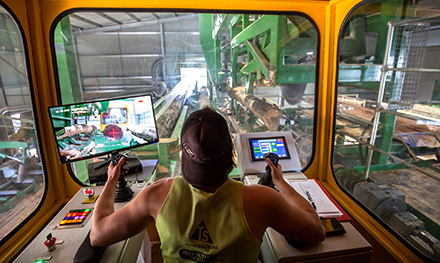Radial Timber is a Victorian based company that grows, mills and distributes a range of unique and standard products from durable and sustainable Victorian Hardwoods. Their latest innovative radial saw technology is unique and proudly developed in Gippsland Victoria. Source: Timberbiz
The radial saw works by taking very small diameter hardwood sawlogs and cuts them up into wedges like a pizza. Once the saw has cut the log into wedges, it then cuts those wedges into boards whilst maximising the recovery of sawn timber from smaller logs.
As such, radial sawing has a range of both environmental and technical benefits. Where conventional sawing methods require large diameter logs, the radial saw helps make small hardwood logs more viable by maximising the yield of high value timber products.
Twenty years ago Radial Timber started with a prototype plant which was very manual labour intensive, and very low in productivity. Over the years the team at Radial kept refining and developing ideas and concepts. They realised if they were ever going move forward, they had to scale up to a fully commercial plant.
As the demand for their radial sawn commercial timber increased, the team made plans to improve production as well as their processing methods. The team at Radial Timber started early discussions with engineering company AE Gibson & Sons, to discuss their concepts and ideas.
They wanted to get a reputable engineering business in Australia to produce the sawmill equipment and help them to develop and improve on the sawmill machinery they already had on site.
Once Radial Timber had the IP in place for the unique process, they knew they were onto a winner. The engineering team at AE Gibson & Sons took it in their stride to engineer a fully customised unique machine. The Gibson team understood the brief and came back with an implementation plan to engineer a suitable solution.
Prior to the Gibson machine design, the initial radial saw was difficult to load and position the log accurately. It was also time consuming to extract the wedges from the cut zone. With the newly designed radial saw the log is positioned and dogged automatically, and the saw cut pattern is PLC controlled.
As each saw cut is completed, the log rotates 45 degrees resulting in eight cuts per log. This greatly increases the machine production outputted and it’s all controlled by an operator located safely in a control cabin.
The timber wedges move from the log saw to a transfer deck and then the resaw, where each wedge is cut into multiple boards. With eight timber wedges and up to five or six boards out of each wedge, this results in 35 or more long timber boards coming out of every small log.
“It helps to predict exactly what you’re recovering from each log, if it’s a six metre timber log most of the boards are six metres long,” Radial Timber owner and managing director Chris McEvoy said.
This was so important, since the company could see the log size coming from forests were getting smaller, and the increased need to recover more from the small logs. This helped them make the decision to invest in improving their overall process with Gibson machinery and technology.
Radial Timber has also invested in plantation forests, with 1000 hectares of plantations that have been planted over the last 20 years with 1000 hectares more to go.
The important thing about the latest radial technology is that it’s ideally suited to plantation timber.
With plantation timber you can grow a tree to a certain size and a certain height. This enables Radial to plan and predict exactly what they are going to get out of every piece of timber. The more uniform the timber product, the higher the recovery with less wastage and the more profitability there will be.






